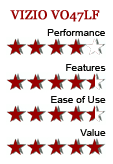
Unless you are looking closely when you pull this 77.5 pound TV (with the black, non-swivel stand) out of its box, you may not notice a subtle design element. The dual textured bezel creates a frame within a frame around the screen - similar to a double matte around a photo.
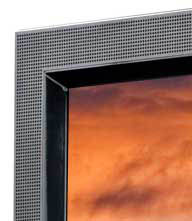
The inner bezel is glossy piano black. The outer part of the frame is a cross-hatched matte black. The effect is understated and elegant, but almost subverted by the shiny gold "1080P FULL HD" label ingrained into the lower right corner of the bezel.
The only other marking on the front is the VIZIO logo that lights a dull yellow when the TV is plugged in and changes to a lighter white when the TV is turned on. This signature feature, which cannot be disabled, used to bug me when I experienced it in earlier VIZIO models. Now, I just ignore it.
The connection panel on the back contains the highest number of HDMI inputs, four, that I have seen on a TV. A stereo pair of Audio inputs is linked to the HDMIs. In addition, the panel offers two Component inputs (YPbPr) with matching stereo Audio Ins, one Composite (with Audio), one VGA (15 pin D-Sub) with a stereo Audio In mini-plug, one S-Video (with audio), and a Service port.
If you want to run audio out of the TV, there's an SPDIF (optical) digital Audio Out and a stereo pair of RCA analog Audio Outs.
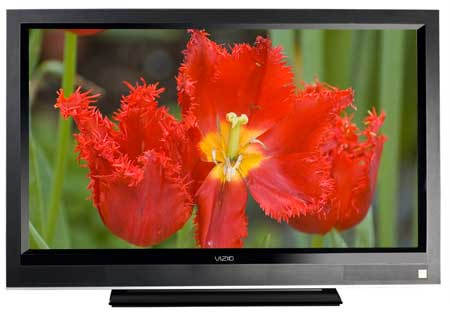
Once again, the connectors are facing downward, which makes them much harder to view. I will admit that the color coded strip above the connectors does make the job easier.
The one RF connector links to the internal NTSC/ATSC/QAM tuner. When setting up the tuners, you scan for the digital (ATSC) and analog (NTSC) channels at the same time. Once they are tuned, you can surf from analog to digital channels by simply hitting the upper or lower portion of the Channel rocker button. Since the tuner system is also Clear QAM compatible, you can attach your cable TV signal directly into the RF connector and tune in unscrambled cable stations.

I'm not a big fan of universal remotes, but this one leaves enough room for all the buttons, which makes navigation much easier. And I definitely appreciate the separate buttons for different Input categories, (HDMI, TV, AV, Component). Often with other TVs, you have to dig through an on screen display (OSD) just to change from one source to another.
The brushed silver base adds a handsome distinctive look. And unlike some backlit remotes that only light up a few of the buttons, VIZIO's illuminates all of them with the touch of any button. It may seem like a simple detail, but it's one that shows that the company is thinking about you, the consumer.
Another highly appreciated gesture is the six foot HDMI cable that is included in the package. Couple that with the poster-sized informative Quick Start Guide and you can be setup and enjoying your 47" LCD in no time.
For the PIP and POP diehards, the VO47LF offers a wide range of possibilities, which can be controlled by the geometrically shaped A, B, C, and D buttons. For example, you can choose three different sizes for the small PIP screen and then you can place it in nine different locations. Or you can opt for the side-by-side dual screen POP.
With a 47" 1080p TV at this price level, I did not expect any extras like a USB port for inserting a flash card or an Ethernet port for connecting to your home network. So I was not surprised that they were absent. Judging from VIZIO's pattern of including new features, I somewhat expect to see them integrated into a few of their 2009 models.
Our basic setup procedure remains the same. We're using the Oppo DV981HD DVD player and the Digital Video Essentials DVD, (the SD version), to calibrate the monitor. We attached the Oppo's HDMI out to the HDMI input on the VIZIO and used test patterns to adjust black level, white level, and color bias. We set the DV981HD to upconvert this standard definition DVD to 1080p, which happens to be the native resolution of the VO47LF.
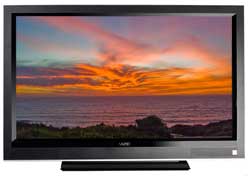
The Picture Menu on the VIZIO provides the basic controls: Brightness, Contrast, Color (Saturation), Tint (Hue) and Sharpness. Also, you have Picture Mode presets labeled Standard, Movie, Game, and Custom. Since we like to have a full range of adjustments, we always pick Custom and work from there.
I found that the default settings were pretty accurate. For my configuration, I pushed the Brightness up a couple of clicks from the midpoint of 50 and Contrast down a nick. I desaturated the Color slightly and inched the Tint a couple of notches towards Green and away from Red.
The Picture Menu also contains a Backlight selection, which I dialed way down in hopes of squeezing out a little deeper black. The manual specifically says that the Backlight setting does not affect Brightness or Contrast, only the overall brilliance of the picture. I turned it down anyway. With LCDs, you live in hope of increasing Black Levels.
The Color Temperature selections are Normal, Warm, Cool or Custom. Cool (9300K) is the default. For added control, Custom includes sliders for Red, Green, and Blue, which default to a midpoint of 127. I chose Custom and nudged the Red lower.
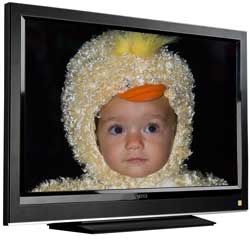
I only needed a short amount of time to tweak the image to a highly satisfactory level. As always, I prefer a limited amount of adjustment tools if they are responsive and effective. The VO47LF's toolset is not extensive, but it allows you to dial in a good looking image quickly and painlessly.
Under the Advanced Video sub-menu are controls for Dynamic Noise Reduction (DNR), Black Level Extender, White Peak Limiter, Color Transient Intensity (CTI), Flesh Tone, Adaptive Luma and Dynamic Contrast Ratio (DCR). With all of them, except DNR and CTI, you simply turn them On or Off.
You would think that I would jump for the Black Level Extender and I did. But I find that often - and this is not just with this VIZIO - advanced controls like these introduce an artificial effect. That was my impression with the Black Level Extender. I figure that if an advanced feature consistently improved the picture quality then it would be integrated into the foundation of the video processing.
The factory default turns some of the Advanced Video selections on. I would suggest that when you are initially setting up your TV that you turn them all off. Once you are pleased with your basic Color and Contrast, then you can read the manual and try the Advanced controls one by one.
Ultimately, you are the best judge of what tweaks look right. For example, I wobbled on the DCR feature. It did brighten the image, but then I thought it reminded me a little too much of a Vivid setting that my eyes have an aversion for. Off, it went.